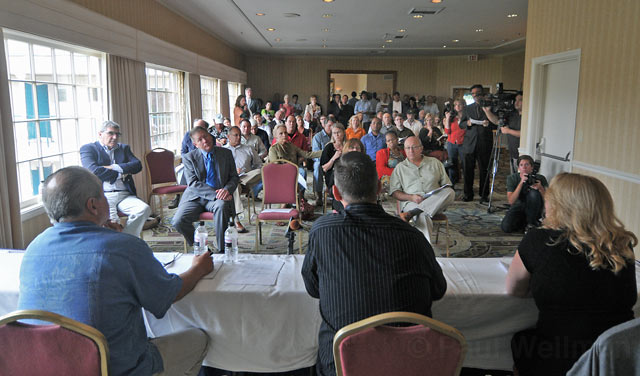Taking It To the Street
Milpas Community Association Vows to Clean up Troubled Corridor

It’s been two years since the Milpas Association disbanded, and since 2008, the corridor running from Anapamu Street down to East Beach — filled with restaurants, businesses, and bustling foot traffic, but often seen as the neglected companion of State Street — has been without the representation of any organized group.
That is, until now, according to Capitol Hardware owner Alan Bleecker and other like-minded activists who are “taking our neighborhood back,” as Bleecker put it during a press conference Tuesday afternoon in a packed banquet room of the Santa Barbara Inn, where he and other organizers formally announced the formation of the Milpas Community Association (MCA). “This area has the potential to be a great little neighborhood,” Bleeker said. “But the Milpas community has sadly experienced many public health and safety issues, such as public urination, crime, youth violence, and drug use.”
Across the street from the hotel at the very bottom of the Milpas passageway sits Cabrillo Ball Field — the center of a lot of the controversy Bleecker refers to. A popular hangout spot for the homeless, the field is also home to prostitution, drug use, and other illegal activity, neighbors say. “It feels unsafe,” Bleecker said. “You know what? It is unsafe.”
The MCA, according to its leadership, will focus on initiatives to increase public safety, improve the beautification of the area, and reduce the incidents of panhandling and loitering. Graffiti removal kits, neighborhood watches, communication with law enforcement, and the implementation the city’s “Real Change, Not Spare Change” program are all part of the group’s program.
Philip Walker, a 36-year resident of the area who attended the press conference, told the gathered crowd during the public comment and Q&A session that he’s seen issues cycle throughout the years and that changes will come when the entire community — from families living 10 people to a rented room to absent condo owners to homeowners who take care of their grass — comes together. “It takes a constructive effort,” he said.
That’s the hope of Mayor Helene Schneider, who said she was “thrilled” that the businesses and community members were formally convening. While the city has taken heat from residents for not adequately dealing with the complex issues facing the corridor, Schneider is looking forward to tackling the problems with help from the MCA. “I heard some frustration, but also that they’re willing to step up and participate,” she said, adding that she was already planning a follow-up meeting with Bleecker and others to “find ways to solve problems as opposed to pointing fingers at one another.”
The finger of blame for the area’s problems often gets pointed at Casa Esperanza, a homeless shelter that popped up in the neighborhood in more than a decade ago, much to the dismay of many of the people in attendance at Tuesday’s press conference. In their eyes, Casa Esperanza in general — and more specifically, its free daily lunch offering to nearly 200 homeless and hungry people — has generated many of the issues that didn’t exist there 10 years ago.
Mike Foley, executive director of Casa Esperanza, said he welcomes the new community group and hopes a fruitful partnership will spring up between the two entities. While he didn’t attend Tuesday’s press conference and was “disappointed” Casa Esperanza won’t be represented on the board of the MCA, he said that “in the absence of a well-organized community association, the struggle for achieving the resources this neighborhood so desperately needs has been a lonely call for help.” The two entities, however, intend to work together toward a common goal, and Casa Esperanza will be involved in an MCA event scheduled for Saturday — “Let’s Clean Up Milpas!” — the first of several beautification projects scheduled.
One homeless fellow, a twenty-something named Steven, stood in the back of the room, taking in the scene of the press conference Tuesday. He listened to people say things like Casa Esperanza should be moved to a more remote area or that no one should get a free meal and the “bad apples” needed to be dealt with. But while he said he first noticed a hint of discrimination and lack of understanding in the words being thrown around by some of the attendees, he also heard things that made him hopeful. There’s a lot of misunderstanding of who the homeless are, Steven continued. He himself just can’t find a job right now, while many on the street have mental illnesses or are addicted to drugs and alcohol. “This is a beginning,” he said.
And many — political leaders, businesspeople, and the homeless — are anxious to see what the end result will be.



